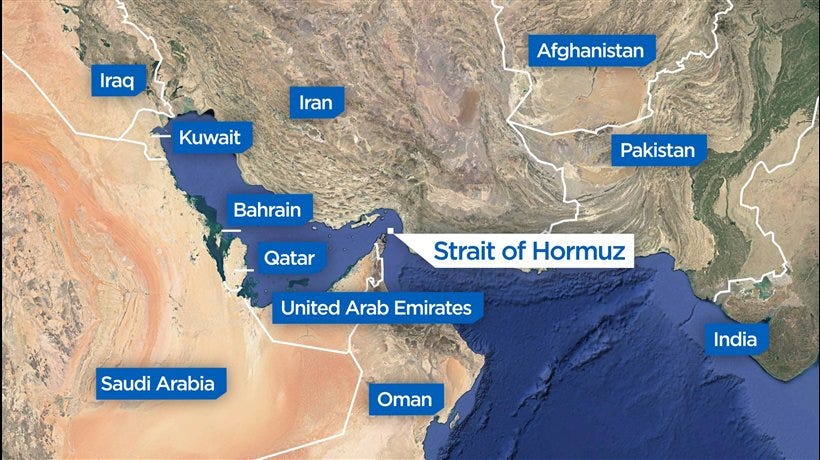Iran Threatens Strait of Hormuz Blockade: Global Oil Markets Brace for Chaos. OIL COULD SOAR North of $100
U.S.-Iran Tensions Soar
Disclaimer
I am Jon Forrest Little, (a fairly well-known precious metals analyst) This disclaimer discloses I adhere to a strict policy of not commenting on highly volatile and emotionally charged subjects such as abortion, gun rights, the state of Israel, or border issues. My focus remains exclusively on commodity markets and related economic developments.
When my reports mention geopolitical events—such as Iran blocking oil shipments in the Strait of Hormuz—these are referenced strictly within the context of commodity analysis and reporting. My intent is to provide market insights for investors and industry professionals, not to express opinions on sensitive political or social issues.
Context:
Iranian leaders have stepped up their warnings against the United States, accusing Washington of actively supporting Israel in recent attacks targeting Iran’s nuclear and military facilities.
Tehran claims that the U.S. provides Israel with crucial military support, which it says enables operations against Iranian interests. In response, Iran has issued explicit threats to retaliate against U.S. military bases across the region if American involvement continues.
Iranian officials assert that their missile and drone arsenals can reach any American installation nearby, raising the stakes for potential conflict. The U.S. has reacted by boosting security measures and initiating partial evacuations at some bases, as fears grow over a possible escalation into a broader regional confrontation.
Iran’s Strait of Hormuz Blockade: A Global Energy Crisis Looms
In a move that has sent shockwaves through international markets, Iran’s armed forces have declared an immediate and indefinite blockade of the Strait of Hormuz, barring all ships from passing through one of the world’s most crucial maritime chokepoints. This dramatic step threatens to cut off the flow of more than 20% of the world’s daily oil supply, raising fears of a global energy crisis and economic turmoil.
Market Chaos and Price Surges
Oil prices skyrocketed within hours of the announcement. Analysts predict that if the blockade continues, prices could double or even triple, with some experts warning of crude oil reaching $120 or even $150 per barrel. Futures markets saw historic one-day gains as traders scrambled to adjust to the new reality. The ripple effects are already being felt in fuel prices, airline stocks, and consumer goods, as industries dependent on oil and shipping brace for higher costs.
Supply Chain Disruption and Global Impact
Countries across Asia, Europe, and North America rely heavily on oil shipped through the Strait of Hormuz. Saudi Arabia, Iraq, the UAE, Kuwait, and Iran itself export vast quantities of crude oil via this narrow passage. Alternative routes, such as pipelines to the Red Sea, are limited in capacity and would require significant time and investment to expand. Shipping companies are considering rerouting vessels, but longer journeys mean increased costs and delays, further straining already fragile global supply chains.
Geopolitical Tensions and Military Risks
Iran’s decision is widely interpreted as a response to recent international pressure, including sanctions and military threats. The United States and its allies have pledged to keep the strait open, raising the specter of a military confrontation. The U.S. Fifth Fleet, stationed in Bahrain, is on high alert, and the international community is watching nervously for signs of escalation.
Looking Ahead
While some analysts question Iran’s ability to sustain a prolonged blockade—given its own reliance on the strait for imports and exports—the mere threat has already destabilized markets. China, as Iran’s largest oil customer, is expected to push for a swift resolution to avoid economic fallout. As the world waits for the next development, governments, businesses, and consumers are preparing for the possibility of a new era of volatility in global energy and geopolitics.
The United States maintains a significant military presence across the Middle East, with numerous bases located in countries surrounding Iran. These facilities include major airbases, naval stations, and logistical hubs in Iraq, Kuwait, Qatar, Saudi Arabia, Bahrain, the United Arab Emirates, and other regional partners. Together, these bases support tens of thousands of U.S. troops and play a crucial role in American defense and security operations throughout the region.
Iran’s government has openly declared its intention to retaliate against U.S. military installations if it believes the United States is involved in attacks on Iranian territory. In recent statements, Iranian officials have warned that all U.S. bases in the region are within range of Iranian missiles and drones. This threat has grown more urgent following a series of strikes on Iranian nuclear and military sites, which Tehran has publicly blamed on a coordinated effort between the United States and Israel. Iranian leaders have stated that any further aggression will be met with direct strikes on U.S. bases, regardless of their location.
In response to these threats, the United States has heightened security measures and begun partial evacuations at some bases, preparing for the possibility of Iranian retaliation. The situation has further escalated tensions between Iran and the United States, raising concerns about a broader regional conflict.





